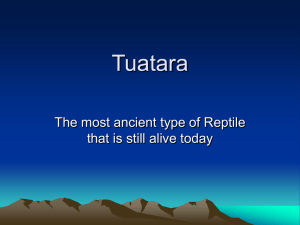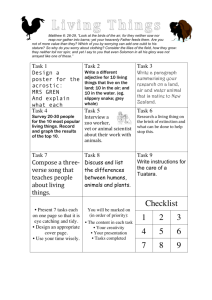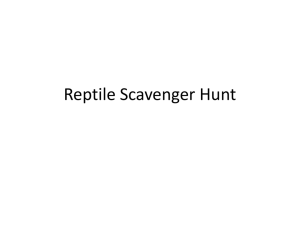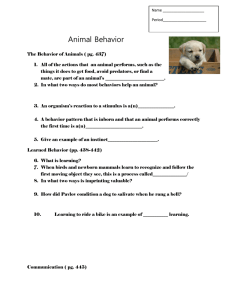Large Male Advantage: Phenotypic and Genetic Correlates of Territoriality in Tuatara J
advertisement
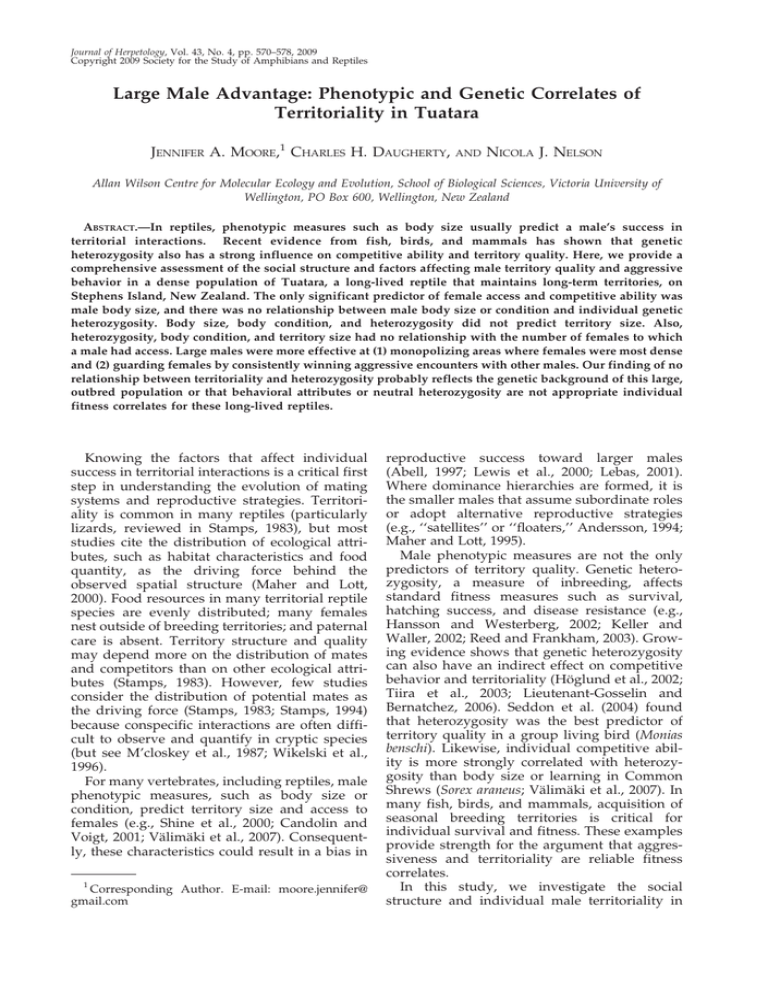
Journal of Herpetology, Vol. 43, No. 4, pp. 570–578, 2009 Copyright 2009 Society for the Study of Amphibians and Reptiles Large Male Advantage: Phenotypic and Genetic Correlates of Territoriality in Tuatara JENNIFER A. MOORE,1 CHARLES H. DAUGHERTY, AND NICOLA J. NELSON Allan Wilson Centre for Molecular Ecology and Evolution, School of Biological Sciences, Victoria University of Wellington, PO Box 600, Wellington, New Zealand ABSTRACT.—In reptiles, phenotypic measures such as body size usually predict a male’s success in territorial interactions. Recent evidence from fish, birds, and mammals has shown that genetic heterozygosity also has a strong influence on competitive ability and territory quality. Here, we provide a comprehensive assessment of the social structure and factors affecting male territory quality and aggressive behavior in a dense population of Tuatara, a long-lived reptile that maintains long-term territories, on Stephens Island, New Zealand. The only significant predictor of female access and competitive ability was male body size, and there was no relationship between male body size or condition and individual genetic heterozygosity. Body size, body condition, and heterozygosity did not predict territory size. Also, heterozygosity, body condition, and territory size had no relationship with the number of females to which a male had access. Large males were more effective at (1) monopolizing areas where females were most dense and (2) guarding females by consistently winning aggressive encounters with other males. Our finding of no relationship between territoriality and heterozygosity probably reflects the genetic background of this large, outbred population or that behavioral attributes or neutral heterozygosity are not appropriate individual fitness correlates for these long-lived reptiles. Knowing the factors that affect individual success in territorial interactions is a critical first step in understanding the evolution of mating systems and reproductive strategies. Territoriality is common in many reptiles (particularly lizards, reviewed in Stamps, 1983), but most studies cite the distribution of ecological attributes, such as habitat characteristics and food quantity, as the driving force behind the observed spatial structure (Maher and Lott, 2000). Food resources in many territorial reptile species are evenly distributed; many females nest outside of breeding territories; and paternal care is absent. Territory structure and quality may depend more on the distribution of mates and competitors than on other ecological attributes (Stamps, 1983). However, few studies consider the distribution of potential mates as the driving force (Stamps, 1983; Stamps, 1994) because conspecific interactions are often difficult to observe and quantify in cryptic species (but see M’closkey et al., 1987; Wikelski et al., 1996). For many vertebrates, including reptiles, male phenotypic measures, such as body size or condition, predict territory size and access to females (e.g., Shine et al., 2000; Candolin and Voigt, 2001; Välimäki et al., 2007). Consequently, these characteristics could result in a bias in 1 Corresponding Author. E-mail: moore.jennifer@ gmail.com reproductive success toward larger males (Abell, 1997; Lewis et al., 2000; Lebas, 2001). Where dominance hierarchies are formed, it is the smaller males that assume subordinate roles or adopt alternative reproductive strategies (e.g., ‘‘satellites’’ or ‘‘floaters,’’ Andersson, 1994; Maher and Lott, 1995). Male phenotypic measures are not the only predictors of territory quality. Genetic heterozygosity, a measure of inbreeding, affects standard fitness measures such as survival, hatching success, and disease resistance (e.g., Hansson and Westerberg, 2002; Keller and Waller, 2002; Reed and Frankham, 2003). Growing evidence shows that genetic heterozygosity can also have an indirect effect on competitive behavior and territoriality (Höglund et al., 2002; Tiira et al., 2003; Lieutenant-Gosselin and Bernatchez, 2006). Seddon et al. (2004) found that heterozygosity was the best predictor of territory quality in a group living bird (Monias benschi). Likewise, individual competitive ability is more strongly correlated with heterozygosity than body size or learning in Common Shrews (Sorex araneus; Välimäki et al., 2007). In many fish, birds, and mammals, acquisition of seasonal breeding territories is critical for individual survival and fitness. These examples provide strength for the argument that aggressiveness and territoriality are reliable fitness correlates. In this study, we investigate the social structure and individual male territoriality in TUATARA SPATIAL STRUCTURE relation to conspecific distribution of a longlived (.85 yr) reptile (Tuatara, Sphenodon punctatus). Tuatara maintain territories throughout the year that vary in size depending on population density and habitat type (Gillingham et al., 1995). Although mating occurs in territories, female Tuatara migrate outside territories to nest as temperatures in the forest are too low to support egg development (Thompson, 1990). Females do not ovulate every year and only reproduce every two to five years (Cree et al., 1992). Anecdotal evidence indicates that large male Tuatara have longterm territory fidelity (i.e., males that were toeclipped 40–50 years ago have been recaptured near their original capture locations, NJN, pers. obs.; Dawbin, 1949, 1962). Previous chance observations of Tuatara mating suggest that reproduction is dominated by large males (Gillingham and Miller, 1991; Cree et al., 1992), although small males have the physiological capacity to mate (Cree et al., 1992). Here, we aim (1) to understand the role of conspecific (interand intrasexual) interactions in overall territoriality and social structure, and (2) to investigate the phenotypic and genetic traits that affect male aggressiveness and physical access to females. Our study site, Stephens Island, New Zealand (known also by its Māori name, Takapourewa; Marlborough Sounds, 40u409S, 174u009E), holds over half of extant Tuatara (the largest and most dense population by orders of magnitude; Gaze, 2001). We first quantify population density and the local adult sex ratio to provide context for the social structure in this population. Theory predicts that at high population densities, the energetic costs of site defense outweigh the reproductive benefits associated with territoriality (Brown, 1969; Emlen and Oring, 1977). Thus, alternative mating strategies should evolve to maximize reproductive success of small or subordinate males (Maher and Lott, 2000), and if present, alternative strategies should be evident in the spatial patterns of males. MATERIALS AND METHODS Study Animals.—Tuatara are the sole extant representative of the reptilian order Rhynchocephalia (Benton, 2000). Endemic to the main and outlying islands of New Zealand, they are now restricted to approximately 30 small, offshore islands caused by predation by introduced mammals (Gaze, 2001). The mating season of Tuatara peaks in March (austral summer), and nesting occurs approximately 8– 10 months later (Cree et al., 1992). Tuatara occupy burrows that can be shared with other 571 individuals and nesting seabirds, and underground burrow systems are dynamic and can be extensive (Newman, 1987). Density and Sex Ratio Estimation.—From 8–16 March 2003, four accessible survey strips (tracks with 3-m borders on either side, from 107–443 m2) in a section of remnant forest (Keeper’s Bush) were surveyed using mark-recapture methods. Strips were systematically surveyed each night, and all Tuatara were captured by hand. Capture location and sex of individual were recorded, the capture site was marked, and all individuals were returned to their capture location. Each animal was marked with a unique number written on their sides (with a nontoxic marker) that was legible throughout the duration of the trip. Capture data for adults were analyzed using closed population models in the program MARK (v3.0 [Win32] Sep 2002; White and Burnham, 1999). Juveniles were excluded from analyses because none were recaptured. Data were grouped according to the following parameters: plot (four survey strips); sex (male, female); and combinations of sex and plot, over eight capture occasions (a time model), with allowance for variation in population number. Other models available in MARK, for example open population models, or those allowing for behavior (when previous capture affects subsequent capture probability) and heterogeneity (individual variation in capture probabilities), may have provided a better fit but could not provide estimates of population number because of small numbers of recaptures (e.g., Nelson et al., 2002). The small sample version of Akaike’s Information Criterion (AICc; Burnham and Anderson, 1998) was used to assess the fit of models. Estimates of population size, including 95% confidence intervals, are presented using the model with the best fit for our data that allowed for capture probabilities to vary with capture occasion (AICc four points greater than the next model; K 5 36). Sex ratios were estimated for each plot using population estimates from the MARK analysis and are reported with upper and lower 95% confidence intervals. Spatial Structure.—In November 2004, three circular study plots (from 314–615 m2, approximately 20–28 m diameter) were located along an accessible track running through forest (Keeper’s Bush). Plot centers were marked with a GPS and postprocessed to increase accuracy. All Tuatara in the study plots were captured by hand, and location, snout–vent length (SVL, mm), mass (g), and sex were recorded. A blood sample (0.5–1.0 ml) was drawn from the caudal vein/artery and stored in 95% ethanol for later genetic analyses. A passive integrated transpon- 572 J. A. MOORE ET AL. der (PIT) tag (11 mm length 3 2 mm width, AVID Identification Systems, Inc., Norco, CA) was inserted subcutaneously for individual identification. A subset of these animals (N 5 100) was marked using a unique color bead tag inserted through the nuchal crests (Fisher and Muth, 1989) to enable individual recognition from a distance. Tuatara that were not bead tagged were recaptured prior to the mating season and marked by writing a unique number on their sides with a nontoxic marker or were recognized by individual idiosyncrasies in tail, head, or spine morphology. Spatial and behavioral data were collected during part of one nesting season (16–28 November 2005) and the peak period of two mating seasons (28 February to 28 March 2006 and 27 February to 27 March 2007). Study plots were surveyed twice daily, and locations of all visible animals were recorded (as a distance and azimuth from plot centers). Mating partners of individuals in the study plots were also known from a concurrent study of the mating system. To assess the factors affecting male competitive ability, all opportunistically observed aggressive interactions between marked males were recorded. ‘‘Losers’’ were defined as males that were chased, bitten, or interrupted in the middle of courtship and fled .1 m from the ‘‘winner,’’ subsequently adopting a submissive posture or running down a burrow. All animals were reweighed and measured following each monitoring period. We did not perform focal animal observations because Tuatara spend the majority of the day sitting motionless (Saint Girons et al., 1980); hence, infrequent activity would have gone undetected using this method. Tuatara locations were entered into a geographic information system (GIS). We defined territories as 95% minimum convex polygons (MCP) because these areas were actively defended and excluded foraging excursions (that occur at night) and nesting migrations (Burt, 1943; Brown and Orians, 1970). MCPs were estimated using Home Range Tools (Rogers et al., 2005) and Hawth’s tools (Beyer, 2004) in ArcGIS 9.1 (ESRI, Redlands, CA). We chose not to implement commonly used kernel density estimators because they are known to be problematic for herpetofauna (Row and BlouinDemers, 2006). Territories were estimated for each individual, using (1) all locations (2005–07 inclusive), (2) only locations from 2006, and (3) only locations from 2007, with the latter two representing consecutive mating seasons (i.e., seasonal territories). An asymptote analysis (ABODE extension; Laver, 2005) found that at least 20 relocations were necessary to accurately estimate territory size; thus, we only included animals with $20 relocations in analyses. In ArcGIS, we calculated the proportion of each male’s territory (95% MCP) that was overlapped by other males. For each male, we summed the percent territory overlap of all other males to determine cumulative percent overlap (as some males overlapped multiple males). We also calculated the percent territory overlap for male–female pairs and counted the number of females that each male’s territory overlapped (5female access). Using point data, activity centers (highest use areas within territories, as defined by Hayne, 1949) were determined for all individuals using the mean center tool in ArcGIS 9.1. Then we used the activity centers to calculate average nearest neighbor statistics for males and females to assess the extent of territoriality. Nearest neighbor indices show whether significant clustering or dispersion exists by comparing the observed spatial distribution to a random expected distribution. Activity centers should be significantly dispersed in highly territorial systems (Brown and Orians, 1970). Genetic Analyses.—DNA extraction and PCR amplification of polymorphic microsatellites for all marked Tuatara followed Moore et al. (2008) and Hay and Lambert (2008). Eight Tuataraspecific loci (C2F, C11P, E11N, H5H, B8P, A12N, C12F, H4H; Aitken et al., 2001; Hay and Lambert, 2008) were amplified. Internal relatedness (IR) is a common measure that is used to determine individual genetic heterozygosity, which weights allele sharing by the frequencies of the alleles involved (Amos et al., 2001). We calculated IR for each individual using an Excel macro (available at http://www.zoo. cam.ac.uk/zoostaff/amos/#ComputerPrograms; Amos et al., 2001). Statistical Analyses.—We performed a linear regression to test whether male SVL or mass predicts contest success (defined as wins per male as a proportion of a male’s total contests). Intersexual differences in mean territory sizes were compared with analyses of variance (ANOVAs). To test whether large males are more effective at maintaining exclusive territories, we compared the cumulative percent territory overlap to male SVL using a Pearson’s correlation. If mate guarding occurs via spatial proximity, within a season, we expect that a male will overlap a greater proportion of his mate’s territory than the average female. Thus, we compared the mean percent overlap of mates to nonmated male–female pairs using an ANOVA. We performed a multiple linear regression analysis to determine the relative effects of SVL, body condition (defined as the residual values from a linear regression of log mass over log SVL), IR, and territory size on female access (the TUATARA SPATIAL STRUCTURE 573 TABLE 1. Nearest neighbor test for complete spatial randomness of Tuatara activity centers on Stephens Island indicates significant structuring of male, but not female, activity centers. Z-scores are measures of standard deviations from a randomly distributed spatial pattern. Mean nearest neighbor distance (NND) is the mean observed distance (in meters) between activity centers. A nearest neighbor ratio (NNR) above 1 indicates dispersion, whereas a NNR below 1 indicates clumping. Asterisks indicate significant dispersion at P , 0.01. Sex Males (N 5 29) Females (N 5 31) Year (study plot) 2006 2006 2007 2007 2006 2006 2007 2007 (1) (3) (1) (3) (1) (3) (1) (3) number of females that each male’s home-range overlaps). We also carried out a multiple linear regression analysis to determine whether SVL, body condition, or IR predicts territory size. Finally, we performed Pearson’s correlations to test the relationship between IR and SVL, mass, and body condition. Statistical analyses that were not performed in ArcGIS 9.1 or MARK (as described above) were carried out in SPSS v.14.0 (SPSS Inc., Chicago, IL). Statistical significance for multiple regression analyses was inferred at P , 0.025 (alpha corrected for multiple comparisons) and P , 0.05 for other tests. All statistical tests were two-tailed, and datasets satisfied the assumptions of normality and homogeneity of variances or were appropriately transformed. RESULTS Density and Sex Ratio.—In total, 225 adult Tuatara were captured in the mark-recapture survey, including 106 females and 119 males. Density estimates for the forest plots averaged 2,732 Tuatara/ha (95% CI 2,260.2, 3,203.8). Sex ratio estimates were approximately 1M : 1F (males 5 0.53, 95% CI 0.51, 0.56; females 5 0.47, 95% CI 0.45, 0.50). Activity Centers/Spatial Proximity.—We were only able to calculate nearest neighbor statistics for plots one and three because we were lacking sufficient data for some animals in plot two. Male activity centers were significantly dispersed in both plots in both years, with the exception of plot three in 2007 (Table 1). In contrast, female activity centers were not significantly dispersed or clustered (Table 1). Male–Male Agonistic Interactions.—We recorded 28 agonistic interactions involving 22 marked males. The number of contests per male ranged from 0–9, and 100% of contests (that were not ‘‘draws,’’ N 5 1) were won by the larger of the two males. Approximately 18% of contests were Mean NND NNR Z 2.03 2.27 3.50 1.66 2.16 1.94 3.62 2.41 1.53 1.45 1.44 1.15 1.24 1.25 1.06 1.23 3.83* 3.40* 3.39* 1.04 1.91 1.85 0.35 1.78 the result of larger males interrupting courtships. There were significant effects of male SVL (r2 5 0.60, b 5 0.77, t 5 5.30, P , 0.001) and mass (r2 5 0.63, b 5 0.79, t 5 5.66, P , 0.001; Fig. 1) on contest success (N 5 21). Territory Structure and Female Access.—From November 2005 to March 2007, we recorded 1,711 locations from 89 marked Tuatara (40 females, 49 males) in the three study plots on Stephens Island. The average number of relocations was 22.7 (range 5 1–67) per male and 16.1 (range 5 1–56) per female. Male territories (N 5 21, mean size 5 30.6 6 3.9 m2, range 5 5.57– 71.58) were significantly larger than female territories (N 5 13, mean size 5 13.9 6 2.8 m2, range 5 1.24–28.18; F1,33 5 9.9, P , 0.01). On average, male territories overlapped 3.9 6 0.6 females (range 5 0–7), whereas female territories overlapped 1.8 6 0.2 males (range 5 0–6). Of male–female pairs that overlapped, male territories overlapped 44.0 6 3.8% of the FIG. 1. Mean mass of male Tuatara (6 1 SE) and the percent of wins in male–male contests (as a function of total male-male contests per male, N 5 22 males) indicate that larger males are more likely to win agonistic encounters. 574 J. A. MOORE ET AL. female’s territory (range 5 1.2–100%). Within a season, mated males overlapped a significantly greater proportion of their mate’s territory than the average unmated pair (mated pairs 5 76.5 6 7.1% female overlap vs. unmated pairs 5 38.3 6 3.9% female overlap; F1,73 5 14.7, P , 0.001). In 2006, 29.6% of males maintained territories completely exclusive of other males, and in 2007, 8.0% of males had exclusive territories. On average, male territories overlapped by 24.9 6 4.2% (N 5 38; Fig 2). Controlling for territory size, there was a significant inverse relationship between male SVL and cumulative percent overlap by other males (r 5 20.36, P 5 0.017), indicating that body size increases a male’s ability to maintain an exclusive territory. Overall, including both males (N 5 20) and females (N 5 13), mean IR was 0.004 6 0.035. For males only, mean IR was 20.007 6 0.04 (range 5 20.27–0.36). Male territory size, body condition, and IR had no significant effects on the number of females overlapped (i.e., female access), but there was a strong effect of body size (log SVL b 5 0.7, t 5 3.5, P 5 0.002; Fig. 3). Male SVL, body condition, and IR had no effects on territory size, and there was no relationship between male IR and SVL, mass, or body condition. DISCUSSION To our knowledge, our results provide the first comprehensive assessment of genetic and morphological traits affecting individual territoriality and competitiveness in a wild reptile population with long-term, stable territoriality. We found no effect of individual genetic heterozygosity on male territory size, body size, or access to females in this very dense population (,2,700 Tuatara/ha). However, male body size, which was not related to territory size, strongly predicted access to females. Large body size confers definite advantages in terms of exclusive access to potential mates. Large males are able to monopolize areas where females are most dense, which is facilitated by the uneven dispersion of females. Large males are not only able to secure territories with a greater number of females overlapping, but they are also better able to maintain those territories and guard mates by consistently outcompeting smaller males. Tuatara are extremely long-lived and have very slow, resource-dependent growth (Dawbin, 1982; Nelson et al., 2002). Males need to be able to monopolize resources to achieve a large body size in this competitive system. Thus, large body size is an honest signal of a male’s capacity to acquire resources and may reflect overall quality. We found no relationship between individual genetic heterozygosity and male body size, territory size, or access to females. This could be caused by a number of factors. First, the Stephens Island population of Tuatara has a very high level of genetic diversity even though it is isolated (MacAvoy et al., 2007). The range of IR-values was narrow and on the more outbred end (e.g., only one male was over 0.3). Thus, we would need a very large sample size with a greater range of inbreeding values to detect even a slight genetic effect (Tiira et al., 2003). Our results add strength to the assertion by Tiira et al. (2006) that the ability to detect heterozygosity-fitness correlations depends strongly on the underlying genetic background of the population (Folstad and Karter, 1992). Furthermore, in studies with moderate sample sizes (e.g., 10–50 individuals, and 8–10 microsatellite loci) that have found a strong relationship between heterozygosity and territory size or competitive ability, acquiring a territory is literally a matter of life or death for the individual (e.g., Slate et al., 2004). Second, in contrast to individual heterozygosity, male body size is highly variable at any point in time (ranging from 160–290 mm SVL in our study). Yet, because Tuatara are so long lived, small males that are not successful now may become successful in the future; hence, lifetime fitness may not vary much between males. To fully understand variation in fitness of individual male Tuatara, a long-term study is needed. A stronger genetic effect could be revealed by examining functional genes (e.g., the major histocompatibility complex), a population with a greater variance in individual heterozygosities, or by comparing individuals from populations with different genetic histories (e.g., inbred vs. outbred; Tiira et al., 2006). Short-lived, territorial lizard species may provide good models to test the relationship between heterozygosity and dominance or territoriality in the future. Although Stephens Island represents a very dense population, our spatial data provide little evidence for alternative reproductive strategies (e.g., ‘‘floaters’’ or ‘‘satellites,’’ roving males with inflated, nondefended home ranges that overlap multiple territories; Brown, 1969; Maher and Lott, 1995). However, male territories often show considerable overlap (e.g., lower left corner of Fig. 2), and large males appear to tolerate the presence of a smaller male because they can restrict small males from mating (by interrupting courtship attempts, JAM, unpubl. data). It may prove advantageous for a small male to associate with a large, successful male (similar to the ‘‘hotshot’’ phenomenon of lekking marine iguanas, Amblyrhynchus crista- TUATARA SPATIAL STRUCTURE 575 FIG. 2. Territories (95% minimum convex polygons) of all male Tuatara (categorized by snout–vent length, SVL) in one study plot from one mating season (March 2006) on Stephens Island. Female symbols represent activity centers of females. tus; Wikelski et al., 1996; Partecke et al., 2002), if he could sneak matings while the large male is otherwise occupied or overtake the territory once he reaches an appropriate size. Home-range size generally increases with body size among species from many taxa, including lizards (Perry and Garland, 2002). When comparing Tuatara territories to ecologically similar lizard species (representing four families) with similar body sizes (drawn from Perry and Garland, 2002, who reviewed home ranges of 222 lizard species), Tuatara territories fall well below the regression lines for lizards and are at least an order of magnitude smaller than the lizard home ranges (see Fig. 4). Why do Tuatara have such small territories compared to other similar-sized reptiles? Although territory sizes can reflect phylogenetic differences, it is more likely that the small territories of Tuatara reflect their energetics, resource availability, and population density. Tuatara are cold-adapted and have very low activity levels and energetic requirements (Saint Girons et al., 1980). Furthermore, nutrient input from extremely high seabird densities on Stephens Island increases primary productivity and has 576 J. A. MOORE ET AL. FIG. 3. Body size of male Tuatara predicts access to females, as represented by the significant linear regression of male body size (snout–vent length, SVL) over the number of females each male’s territory overlaps. flow-through effects to invertebrate herbivores (i.e., Tuatara prey; Mulder and Keall, 2001). Population density can also affect home range or territory size within a species (Kwiatkowski and Sullivan, 2002). On Stephens Island, Tuatara appear to be able to acquire all necessary metabolic and reproductive resources in an unexpectedly small space; a size that is contrary to patterns seen in lizards, yet consistent with a highly dense population of a cold-adapted reptile with low energetic requirements and high nutrient availability. By investigating the social structure of Tuatara, our findings shed new light on patterns of territoriality in vertebrates. Although individual heterozygosity, territory size, or body condition did not increase the likelihood of a male Tuatara gaining access to mates, body size did. We suspect that future research may reveal similar patterns in genetically diverse, large, outbred populations of other territorial taxa. Genetic effects may be more apparent in short-lived species (that only experience one or two breeding seasons in a lifetime), where the variance in male body size is small and traits affecting competitive ability are tightly linked to individual heterozygosity. In this dense, territorial system, intrasexual competition and female access are highly skewed toward large males, a pattern that is consistent with that of ecologically similar yet phylogenetically distant lizards. Future research should address whether large male advantage, in terms of female access, FIG. 4. Territory/home-range area as a function of snout–vent length (SVL) for lizard species (N 5 7, males 5 closed circles, females 5 open circles) with body sizes similar to Tuatara (Sphenodon punctatus). Male and female Tuatara fall well below the regression lines for male and female lizard home-range area versus SVL. Note log scale for home-range area. Lizard home range and body size data drawn from appendix A in Perry and Garland, 2002. Lizard species and original data sources include Anolis cuvieri, Anolis frenatus, Schoener and Schoener, 1982; Chlamydosaurus kingii, Griffiths, 1999; Cyclura carinata, Iverson, 1979; Iguana iguana, Rand et al., 1989; Lacerta lepida, Castilla, 1989; Sauromalus obesus, Johnson, 1965. TUATARA SPATIAL STRUCTURE actually equates to realized increases in reproductive success. Acknowledgments.—We acknowledge the New Zealand Department of Conservation, particularly C. Allen, M. Aviss, J. DeVries, and P. Gaze for support and permits (NM-18922-CAP) to conduct field work on Stephens Island. We also thank Ngāti Koata no Rangitoto ki te Tonga trust for supporting our research. S. Pledger provided assistance with population modeling. J. Gillingham, S. Godfrey, S. Keall, K. Hare, H. Miller, K. Britton, K. Miller, and the VUW herpetological hatchet group provided assistance in the field and comments on the manuscript. Ethics approval for invasive techniques was obtained from the Victoria University of Wellington Animal Ethics Committee (approval 2006R12). Funding for this research was provided by the Allan Wilson Centre for Molecular Ecology and Evolution, the Zoological Society of San Diego, and Education New Zealand. LITERATURE CITED ABELL, A. J. 1997. Estimating paternity with spatial behaviour and DNA fingerprinting in the Striped Plateau Lizard, Sceloporus virgatus (Phrynosomatidae). Behavioral Ecology and Sociobiology 41: 217–226. AITKEN, N., J. M. HAY, S. D. SARRE, D. M. LAMBERT, AND C. H. DAUGHERTY. 2001. Microsatellite DNA markers for tuatara (Sphenodon spp.). Conservation Genetics 2:183–185. AMOS, W., J. W. WILMER, K. FULLARD, T. M. BURG, J. P. CROXALL, D. BLOCH, AND T. COULSON. 2001. The influence of parental relatedness on reproductive success. Proceedings of the Royal Society of London Series B-Biological Sciences 268:2021– 2027. ANDERSSON, M. 1994. Sexual selection: Monographs in Behavior and Ecology. Princeton University Press, Princeton, NJ. BENTON, M. J. 2000. Vertebrate Palaeontology. Blackwell Science, London. BEYER, H. L. 2004. Hawth’s Analysis Tools for ArcGIS. Available from: http://www.spatialecology.com/ htools. BROWN, J. L. 1969. Territorial behavior and population regulation in birds. Wilson Bulletin 81:293–329. BROWN, J. L., AND G. H. ORIANS. 1970. Spacing patterns in mobile animals. Annual Review of Ecology and Systematics 1:239–262. BURNHAM, K. P., AND D. R. ANDERSON. 1998. Model Selection and Inference. A Practical InformationTheoretic Approach. Springer-Verlag, Inc., New York. BURT, W. H. 1943. Territoriality and home range concepts as applied to mammals. Journal of Mammalogy 24:346–352. CANDOLIN, L., AND H. R. VOIGT. 2001. Correlation between male size and territory quality: consequence of male competition or predation susceptibility? Oikos 95:225–230. 577 CASTILLA, A. M. 1989. Autoecologia del lagarto ocelado (Lacerta lepida). Unpubl. Ph.D. diss., University Autonoma of Madrid, Madrid, Spain. CREE, A., J. F. COCKREM, AND L. J. GUILLETTE JR. 1992. Reproductive cycles of male and female Tuatara (Sphenodon punctatus) on Stephens Island, New Zealand. Journal of Zoology 226:199–217. DAWBIN, W. H. 1949. The Tuatara. Tuatara 2:91–96. ———. 1962. The Tuatara in its natural habitat. Endeavour 21:16–24. ———. 1982. The Tuatara, Sphenodon punctatus: Aspects of life history, growth and longevity. In D. G. Newman (ed.), New Zealand Herpetology, pp. 237–250. New Zealand Wildlife Service, Wellington. EMLEN, S. T., AND L. W. ORING. 1977. Ecology, sexual selection, and evolution of mating systems. Science 197:215–223. FISHER, M., AND A. MUTH. 1989. A technique for permanently marking lizards. Herpetological Review 20:45–46. FOLSTAD, I., AND A. J. KARTER. 1992. Parasites, bright males, and the immunocompetence handicap hypothesis. American Naturalist 139:603–622. GAZE, P. 2001. Tuatara Recovery Plan 2001–2011. Biodiversity Recovery Unit, New Zealand Department of Conservation, Wellington. GILLINGHAM, J. C., AND T. J. MILLER. 1991. Reproductive ethology of the Tuatara Sphenodon punctatus: applications in captive breeding. International Zoo Yearbook 30:157–164. GILLINGHAM, J. C., C. CARMICHAEL, AND T. MILLER. 1995. Social behavior of the Tuatara, Sphenodon punctatus. Herpetological Monographs 9:5–16. GRIFFITHS, A. D. 1999. Demography and home range of the Frillneck Lizard, Chlamydosaurus kingii (Agamidae) in Northern Australia. Copeia 1999:1089–1096. HANSSON, B., AND L. WESTERBERG. 2002. On the correlation between heterozygosity and fitness in natural populations. Molecular Ecology 11:2467– 2474. HAY, J. M., AND D. M. LAMBERT. 2008. Microsatellite DNA loci identify individuals and provide no evidence for multiple paternity in wild Tuatara (Sphenodon: Reptilia). Conservation Genetics 9:1039–1043. HAYNE, D. W. 1949. Calculation of size of home range. Journal of Mammalogy 30:1–18. HÖGLUND, J., S. B. PIERTNEY, R. V. ALATALO, J. LINDELL, A. LUNDBERG, AND P. T. RINTAMAKI. 2002. Inbreeding depression and male fitness in black grouse. Proceedings of the Royal Society of London Series B-Biological Sciences 269:711–715. IVERSON, J. B. 1979. Behavior and ecology of the Rock Iguana Cyclura carinata. Bulletin of the Florida State Museum of Biological Science 24:175–358. JOHNSON, S. R. 1965. An ecological study of Chuckwalla Sauromalus obesus Baird in Western Mojave Desert. American Midland Naturalist 73:1–29. KELLER, L. F., AND D. M. WALLER. 2002. Inbreeding effects in wild populations. Trends in Ecology and Evolution 17:230–241. KWIATKOWSKI, M. A., AND B. K. SULLIVAN. 2002. Mating system structure and population density in a polygynous lizard, Sauromalus obesus (5 ater). Behavioral Ecology 13:201–208. 578 J. A. MOORE ET AL. LAVER, P. 2005. ABODE: Kernel home range estimation for ArcGIS, version Beta v.2, Department of Fisheries and Wildlife Sciences, Virginia Tech, Blacksburg. LEBAS, N. R. 2001. Microsatellite determination of male reproductive success in a natural population of the territorial Ornate Dragon Lizard, Ctenophorus ornatus. Molecular Ecology 10:193–203. LEWIS, A. R., G. TIRADO, AND J. SEPULVEDA. 2000. Body size and paternity in a Teiid Lizard (Ameiva exsul). Journal of Herpetology 34:110–120. LIEUTENANT-GOSSELIN, M., AND L. BERNATCHEZ. 2006. Local heterozygosity-fitness correlations with global positive effects on fitness in Threespine Stickleback. Evolution 60:1658–1668. MACAVOY, E. S., L. M. MCGIBBON, J. P. SAINSBURY, H. LAWRENCE, C. A. WILSON, C. H. DAUGHERTY, AND G. K. CHAMBERS. 2007. Genetic variation in island populations of Tuatara (Sphenodon spp) inferred from microsatellite markers. Conservation Genetics 8:305–318. MAHER, C. R., AND D. F. LOTT. 1995. Definitions of territoriality used in the study of variation in vertebrate spacing systems. Animal Behaviour 49:1581–1597. ———. 2000. A review of ecological determinants of territoriality within vertebrate species. American Midland Naturalist 143:1–29. M’CLOSKEY, R. T., K. A. BAIA, AND R. W. RUSSELL. 1987. Tree Lizard (Urosaurus ornatus) territories: experimental perturbation of the sex ratio. Ecology 68:2059–2062. MOORE, J. A., N. J. NELSON, S. N. KEALL, AND C. H. DAUGHERTY. 2008. Implications of social dominance and multiple paternity for the genetic diversity of a captive-bred reptile population (Tuatara). Conservation Genetics 9:1243–1251. MULDER, C. P. H., AND S. N. KEALL. 2001. Burrowing seabirds and reptiles: impacts on seeds, seedlings and soils in an island forest in New Zealand. Oecologia 127:350–360. NELSON, N. J., S. N. KEALL, S. PLEDGER, AND C. H. DAUGHERTY. 2002. Male-biased sex ratio in a small tuatara population. Journal of Biogeography 29:633–640. NEWMAN, D. G. 1987. Burrow use and population densities of Tuatara (Sphenodon punctatus) and how they are influenced by fairy prions (Pachyptila turtur) on Stephens Island, New Zealand. Herpetologica 43:336–344. PARTECKE, J., A. vON HAESELER, AND M. WIKELSKI. 2002. Territory establishment in lekking Marine Iguanas, Amblyrhynchus cristatus: support for the hotshot mechanism. Behavioral Ecology and Sociobiology 51:579–587. PERRY, G., AND T. GARLAND. 2002. Lizard home ranges revisited: effects of sex, body size, diet, habitat, and phylogeny. Ecology 83:1870–1885. RAND, A. S., E. FONT, D. RAMOS, D. I. WERNER, AND B. C. BOCK. 1989. Home range in Green Iguanas (Iguana iguana) in Panama. Copeia 1989:217– 221. REED, D. H., AND R. FRANKHAM. 2003. Correlation between fitness and genetic diversity. Conservation Biology 17:230–237. ROGERS, A. R., A. P. CARR, L. SMITH, AND J. G. KIE. 2005. HRT: Home Range Tools for ArcGIS. Ontario Ministry of Natural Resources, Centre for Northern Forest Ecosystem Research, Thunder Bay, ON, Canada. ROW, J. R., AND G. BLOUIN-DEMERS. 2006. Kernels are not accurate estimators of home-range size for herpetofauna. Copeia 2006:797–802. SAINT GIRONS, H., B. D. BELL, AND D. G. NEWMAN. 1980. Observations on the activity and thermoregulation of the Tuatara, Sphenodon punctatus (Reptilia: Rhynchocephalia), on Stephens Island. New Zealand Journal of Zoology 7:551–556. SCHOENER, T. W., AND A. SCHOENER. 1982. Intraspecific variation in home range size in some Anolis lizards. Ecology 63:809–823. SEDDON, N., W. AMOS, R. A. MULDER, AND J. A. TOBIAS. 2004. Male heterozygosity predicts territory size, song structure and reproductive success in a cooperatively breeding bird. Proceedings of the Royal Society of London Series B-Biological Sciences 271:1823–1829. SHINE, R., M. OLSSON, I. T. MOORE, M. P. LEMASTER, M. GREENE, AND R. T. MASON. 2000. Body size enhances mating success in Garter Snakes. Animal Behaviour 59:F4–F11. SLATE, J., P. DAVID, K. G. DODDS, B. A. VEENVLIET, B. C. GLASS, T. E. BROAD, AND J. C. MCEWAN. 2004. Understanding the relationship between the inbreeding coefficient and multilocus heterozygosity: theoretical expectations and empirical data. Heredity 93:255–265. STAMPS, J. 1994. Territorial behavior: testing the assumptions. Advances in the Study of Behavior 23:173–232. STAMPS, J. A. 1983. Sexual selection, sexual dimorphism, and territoriality. In R. B. Huey, E. R. Pianka, and T. W. Schoener (eds.), Lizard Ecology: Studies of a Model Organism, pp. 169–204. Harvard University Press, Cambridge, MA. THOMPSON, M. B. 1990. Incubation of eggs of Tuatara, Sphenodon punctatus. Journal of Zoology 222:303– 318. TIIRA, K., A. LAURILA, N. PEUHKURI, J. PIIRONEN, E. RANTA, AND C. R. PRIMMER. 2003. Aggressiveness is associated with genetic diversity in landlocked salmon (Salmo salar). Molecular Ecology 12:2399–2407. TIIRA, K., A. LAURILA, K. ENBERG, J. PIIRONEN, S. AIKIO, E. RANTA, AND C. R. PRIMMER. 2006. Do dominants have higher heterozygosity? Social status and genetic variation in Brown Trout, Salmo trutta. Behavioral Ecology and Sociobiology 59:657–665. VÄLIMÄKI, K., G. HINTEN, AND I. HANSKI. 2007. Inbreeding and competitive ability in the Common Shrew (Sorex araneus). Behavioral Ecology and Sociobiology 61:997–1005. WHITE, G. C., AND K. P. BURNHAM. 1999. Program MARK: survival estimation from populations of marked animals. Bird Study Supplement 1 46:120–139. WIKELSKI, M., C. CARBONE, AND F. TRILLMICH. 1996. Lekking in marine iguanas: female grouping and male reproductive strategies. Animal Behaviour 52:581–596. Accepted: 7 January 2009.
